The world of home decor is constantly evolving, with each year bringing its own set of trends, aesthetics, and ideas that push the boundaries of creativity and design. After our most recent trip to the Las Vegas Market, we discovered several unique trends that promise to bring a fresh wave of inspiration for interior enthusiasts and homeowners. From the resurgence of statement lighting to the soft, inviting curves of furniture, the upcoming trends underscore a blend of boldness, comfort, and sophistication. In this article, we'll explore the top home decor trends for 2024, ensuring your space stays at the forefront of style.
What’s In: Statement Lighting: Brightening Spaces with Boldness

Picture courtesy of Visual Comfort
Lighting isn't just functional; it's an art form. In 2024, statement lighting takes center stage, morphing from mere utility to the focal point of any room. Imagine fixtures that combine innovative materials with unusual shapes, casting more than just light. We’re seeing tons of lighting in a variety of metals, with the most popular being champagne gold or matte black. Ditto for statement pieces that offer unique textures like twine or seashell-like materials. Lighting is like jewelry in a room, so if you’re looking for an instant transformation, new fixtures are something to consider splurging on.
Curved Furniture: Softening Spaces with Elegance
What was once thought of as a flash-in-the-pan design trend has proven to have some staying power? Homeowners are opting to gather in person now more than ever and curved pieces allow for better engagement. They also bring a softer, more organic touch to interiors, inviting relaxation and comfort while offering a nod to retro glamour. The most popular pieces tend to be coffee tables, dining tables, and barrel-shaped accent chairs with neutral fabrics and various wood tones. These pieces showcase a sophisticated blend of organic forms and enduring textures, offering a unique aesthetic that combines contemporary design with the timeless beauty of nature.
Muted and Neutral Textures: A Canvas for Creativity
In the coming year, interiors will shift towards muted and neutral textures, providing a serene and comforting aesthetic. Driftwood, leather, seagrass, twine, jute, and textured fabrics are appearing in everything from accent chairs to lighting and we love it. This trend celebrates simplicity and subtlety, allowing for a design style that has depth and character and is fresh and modern to the eye.

Picture courtesy of Universal Furniture
Gold Accents: Adding a Touch of Luxe
Gold has always symbolized luxury, but in 2024, it finds new expressions in home decor. From brushed to matte finishes, gold accents add a warm glow, enriching spaces with a timeless elegance that transcends seasons. But, be careful to not overdo it! Like the gold from the 80’s and 90’s – it can come back to haunt you. Mixed with more grounding neutral tones and textures, pops of gold can be a wonderful accent to any aesthetic. We especially enjoy using it in: lighting, mirrors, some plumbing fixtures, tabletop accent pieces, and frames.
Hints of Blue and Rust-Colored Fabrics and Patterns: Injecting Color with Purpose
While neutral palettes set the stage, strategic pops of color will play a pivotal role in adding dimension and interest to spaces this year. Specifically, shades of blue and rust offer a perfect balance between calm and excitement, infusing spaces with life and vibrancy. Blue/gray accent walls, navy velvet accent chairs, rust-colored pillows, and throws are some ways to incorporate these fun colors into your home.
Statement Art: Personal Expressions on a Grand Scale
Art becomes more personal and impactful in 2024, with oversized pieces making bold statements. Whether it's abstract paintings, digital prints, or sculptural pieces, art in interior design is all about expressing individuality on a grand scale. The key is to find pieces that work well with your overall aesthetic and are the correct size for the space. Think big and work to find unique art that could be a conversation piece but doesn’t necessarily overpower a room. Avoid generically manufactured pieces, word art, or items that are too matchy-matchy.
Mixing in Antique Pieces: Blending Past and Present

Photo courtesy of Ballard Designs
You’ve probably heard the term “grand millennial décor” – which works to incorporate some of the styles that granny may have loved with modern-day pieces. This trend celebrates the beauty of imperfection and the stories embedded in vintage finds, offering a contrast that is both intriguing and harmonious. Think large-scale floral wallpaper in a powder bath or accent wall, collections of blue & white plates or vases on bookcases, furniture with rattan & wicker accents, and needlepoint pillows.
What It All Means
The home decor trends for 2024 are all about creating spaces that reflect personal style while fostering comfort and functionality. Whether it's through the bold statement of lighting fixtures, the elegance of curved furniture, or the warmth of gold accents, each trend offers a unique avenue for expression. By blending these elements with the serene backdrop of muted textures, pops of vibrant colors, and the timeless appeal of antiques, your home can become a true reflection of contemporary design sensibilities.
Remember, while trends provide a directional guide, the most important aspect of home decor is creating a space that resonates with you. Let these trends be a jumping-off point for creating a space that you can love. And if you’re still not sure how to bring the latest trends together to work for you, don’t hesitate to reach out and learn more about our interior design and decorating services.
As technology continues to advance, artificial intelligence (AI) has made its way into various aspects of our lives, including interior design. AI-powered interior design platforms have gained popularity in recent years, offering users an innovative and convenient way to plan and decorate their homes. However, as with any technology, there are both advantages and disadvantages to using AI for interior design. In this blog post, we will discuss the pros and cons of using an AI-powered platform to decorate your home.
Pros of AI-Powered Interior Design Platforms
1. Affordability
One of the most significant benefits of using AI-powered interior design platforms is cost savings. While more personalized than AI options, traditional interior design services can be outside the budget for some homeowners. In contrast, AI platforms offer a more affordable alternative, with many providing low-cost access to design tools and resources.
2. Convenience and accessibility
AI-powered platforms allow users to plan and visualize their home's interior design from the comfort of their own home, without the need for in-person consultations or meetings. This convenience is particularly beneficial for those with busy schedules or who live in remote areas with limited access to professional designers.
3. Speed and efficiency
The use of AI technology allows these platforms to generate design plans and renderings quickly and efficiently, reducing the time it takes to create a finished design. This rapid turnaround can be particularly helpful for those working on tight deadlines or who want to see multiple design options before making a decision.
4. Collaboration and sharing
Many AI-powered interior design platforms include social networking features, allowing users to share their designs with friends, family, or even a professional designer for feedback and advice. This collaborative aspect can be helpful for those who need a second opinion or want to involve others in the design process.
Cons of AI-Powered Interior Design Platforms
1. Lack of personal touch
One of the main drawbacks of using AI-powered interior design platforms is the potential loss of the personal touch that comes with working with a human designer. While AI algorithms can generate design suggestions based on user input, they may not fully capture the nuances of an individual's style or personality. Some users may find that their AI-generated designs lack the warmth and character of a design created by a professional. Additionally, AI-generated designs often lack the attention to detail that a human designer will offer.
 2. Limited creativity
2. Limited creativity
While AI platforms offer some options for furniture, materials, and decor items, the available options may still be limited compared to the vast array of products on the market. Users may find that their design choices are constrained by the platform's offerings, potentially stifling their creativity and limiting their ability to create a truly unique space.
3. Technical issues and learning curve
As with any technology, AI-powered interior design platforms may suffer from technical glitches or errors that can impact the user experience. Additionally, some users may find that there is a learning curve associated with using these platforms, particularly if they are not familiar with design software or tools.
4. Potential inaccuracies
While many AI platforms use advanced algorithms and 3D rendering technology to create realistic design plans, there is always the potential for inaccuracies or discrepancies between the digital design and the finished product. Users should be aware of this possibility and be prepared to make adjustments as needed during the implementation process. AI platforms also do not have the in-depth knowledge that human designers do when it comes to material performance, product quality or accurate lead times for all the materials that go into a newly designed room.
5. Dependence on technology
Finally, the use of AI-powered interior design platforms may contribute to an increasing reliance on technology for everyday tasks and decision-making. While technology can undoubtedly offer valuable tools and resources, it is essential to strike a balance between embracing innovation and preserving the human element in our lives.
Will Robots Rule?
AI-powered interior design platforms offer numerous benefits, including cost savings, convenience, customization, and speed. However, there are also drawbacks to consider, such as the potential lack of personal touch, limited creativity, technical issues, inaccuracies, and increased dependence on technology.
Ultimately, the decision to use an AI-powered platform for interior design will depend on your individual needs, preferences, and comfort level with technology. If you value the personal touch and expertise that comes with working with a professional designer, an AI platform may not be the best fit for you.
It’s no secret that as the real estate industry continues to be very competitive, home buyers are looking at more than just the number of bedrooms and bathrooms when they tour properties. They're also looking at the interior design of a place to get a sense of how it would look and feel to live there. Well-curated and updated homes are highly desirable and usually sell for top dollar. At the same time, homes that are designed with only the latest trends in mind, will become outdated quickly and be yesterday’s news before that new shade of mauve paint can dry. In this blog post, we'll walk through some of the biggest interior design trends for 2023 that all homeowners should consider—and which ones can be ignored.
Trends to Adopt
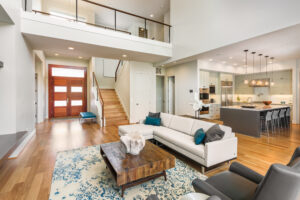 One trend that is sure to be popular in 2023 is sustainability. Homeowners are becoming increasingly aware of their impact on the environment and want to incorporate more eco-friendly elements into their homes. This could mean anything from installing solar panels or investing in energy-efficient appliances & windows to using recycled materials or repurposed furniture.
One trend that is sure to be popular in 2023 is sustainability. Homeowners are becoming increasingly aware of their impact on the environment and want to incorporate more eco-friendly elements into their homes. This could mean anything from installing solar panels or investing in energy-efficient appliances & windows to using recycled materials or repurposed furniture.
Another trend that is top-of-mind with home buyers is neutral and earth-tone paints, backsplash tile, and flooring. The days of everything gray are long gone, and design trends are leaning more towards neutral whites and greige paints, followed by lighter-colored flooring and earthy and bright tile selections.
Finally, texture and black matte will be big in 2023 when it comes to interior design trends. This trend focuses on making spaces look lush and inviting by incorporating different textures, patterns, and neutral colors into one room. Think velvet cushions paired with wicker furniture and luxurious throws—the possibilities are endless! Black matte with some touches of gold is also heavily trending when it comes to lighting fixtures, plumbing hardware, and cabinet and door hardware. By emphasizing these updates in your listings, you’ll be able to show potential buyers how they can really make a space their own with minimal effort but maximum impact.
Trends To Ignore
All-white minimalism – especially when it comes to the kitchen – has had its 15 minutes of fame! Buyers are now more interested in
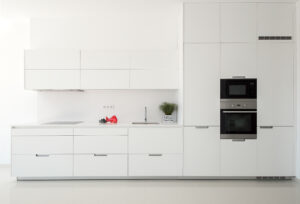
All white & modern kitchens are now outdated!
warm wood tones, texture, and functionality in the areas that are used most – kitchens and bathrooms. Warm, cozy, and inviting rooms are sure to excite buyers, ultimately resulting in a quick sale for top dollar.
Bold colors on the walls in rich hues of greens, browns, and pinks are starting to make a major comeback. However, these very trendy colors may not be everyone’s taste. Stick to light and bright neutral colors throughout the home if you want to appeal to a wide array of buyers.
Accent walls and well-executed millwork can be an asset in any home remodel, but it is possible to overdo it. Don’t go overboard with the board and batten or fluted wall panels. Pick one or two rooms that would benefit from this type of wall treatment and make sure the overall aesthetic works with the rest of the home’s design style.
Conclusion:
The key takeaway here is that there are plenty of exciting interior design trends coming up in 2023 that realtors and homeowners should recognize and leverage when marketing their properties! Sustainability will continue to be important as people become more mindful of environmental impacts; meanwhile warm and neutral décor with lots of texture will add personality and life into any home without having to invest too much money or effort upfront for renovations! Finally, super minimalist decor or the latest shade of pink won't have nearly as much pull this year - so avoid including either one in your listings unless specifically requested by potential buyers! All things considered now's the perfect time to capitalize on these upcoming trends!
As we begin a new year, many homeowners are considering making updates to their homes. One of the biggest changes you can make to increase the look and feel of your space, as well as the value of your home, is installing new flooring. Before you break out the jackhammer, read on to learn more about what products are hot and how much new flooring in Arizona may cost you.
While it may be very exciting to get new flooring, before applying any new materials (for the most part) the old flooring needs to be removed prior to installation. As you are calculating the cost of new flooring for your home, be sure you factor in the cost of removal:
Average Cost to Demo Hardwood: $4 SQFT
Average Cost to Demo Tile: $3.25 SQFT
Average Cost to Demo Engineered Hardwood: $4 SQFT
Average Cost to Demo Vinyl: $1 SQFT
If you have tile in your home that needs to be removed, you can opt for a “dustless” removal process that helps keep your home clean and free of all debris that goes along with removing old flooring. On average, dustless removal will be $2 to $3 dollars more vs. standard removal techniques.
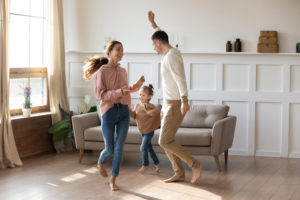
There are so many uses for vinyl flooring; it’s no wonder that it’s rising fast as an affordable, sustainable, and fashionable option.
Vinyl is durable and easy to clean while often less expensive and more available than other flooring options. While vinyl used to be an immediate throw-away from outmoded 70’s design, modern technology has changed the uses of vinyl. From one large sheet of cheap flooring, luxury vinyl now offers an endless array of designs and textures to mimic wood and stone.
Luxury vinyl typically falls into two categories: planks and tile. The main difference between a plank and a tile is its dimension, with a plank having a rectangular shape and a tile a square shape.
Vinyl planks are often used to imitate a hardwood floor at a fraction of the price and a limitless array of colors, widths, and textures. You can get luxury planks that appear hand-scraped or wire-brushed. If you prefer neutral grays, you’ll find those shades too! You can even get planks crafted with a micro bevel on the edge of each plank, making it seem like your floor is genuine wood.
While vinyl planks can also imitate stone, it’s more common to see stone textures in vinyl tiles. Vinyl tiles are a great, durable option for kitchens and bathrooms in particular! Add some grout for a professional finish that could dupe for real marble or stonework.
Luxury Vinyl Pricing
Average professional install per square foot: $3 SQFT
Average price per square foot for materials: $2-$5 SQFT
Average total cost: $8 SQFT
Engineered hardwood is an excellent option if you want to incorporate real wood but still keep costs down. Engineered hardwood has two parts-- the veneer and the core. The veneer is the thinnest part that shows the desired color and texture. The core is made of less pretty wood but offers the long-lasting durability you need from your floors.
There are a few different kinds of hardwood that will change the location and ease of install.
Last is the easiest and newest option-- the click-lock method. Click-lock planks have grooves that easily fit together and stay locked once placed. It’s become an increasingly popular option since you can ditch the glue and nails and works equally well on cement and wood subfloors. It also makes it easiest to replace small sections if damaged!
Engineered Hardwood Pricing
Professional Install: $4 SQFT
Price per square foot: $6-$10 SQFT
Average cost: $14 SQFT
If you’ve got the budget, nothing can truly replace authentic porcelain or ceramic tile. These tiles can be handcrafted in a variety of shapes and sizes. If you’re going for a more customized look, these tiles can make a great statement.
While each tile material has its place, it’s important to note that porcelain and ceramic options are not interchangeable. Porcelain tiles are rated at a greater hardness, meaning that they are less likely to break and chip when used on the floor. Ceramic tiles are softer, so you’ll likely have a smaller range of selection approved for flooring.
Porcelain price per square foot: $2-$30, but most people spend between $3-$10
Porcelain Professional Install: $4.25 - $10 per square foot
Ceramic tile per square foot: $0.50-$35
Ceramic Professional Install: $4-10 per square foot
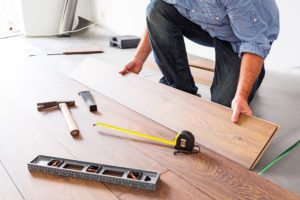
The price of your hardwood floors can range dramatically depending on the class of wood you’re looking for. Most commonly purchased hardwoods range from $6 to $12, making them competitively priced with vinyl options. Still, if you prefer more exclusive or exotic woods, you can quickly go over $40 per square foot.
Installation costs are similar to the cost of engineered hardwood. However, keep in mind that more intricate patterns-- like herringbone-- will cost more.
Finally, hardwoods can require more maintenance than other types of flooring. They can be at higher risk for scratches and warping (clean liquid spills immediately). Real hardwood floors offer a luxe look but may not be practical for homes with small children or pets.
Professional Install per square foot: $8 to $18 SQFT
Price per square foot: $6-$12, up to $40+ for exotic flooring
Average cost for new hardwood floors: $14 to $35 per square foot
Pro Tips:
Need Help Narrowing Your Options?
There are so many great and affordable flooring options now available, so it can be challenging to know which product will be the best use of your time and money. You may also need help determining how your flooring will combine with your existing appliances, paint, finishes, and decor. Should you need assistance with picking out the perfect flooring for your home, don’t hesitate to reach out. We are happy to help!
Did you know that something as simple as color can add thousands to your house’s potential value? Zillow has found that homes can sell for more than 5k over asking... just by having a consistent, neutral, and synergistic color palette!
Your home should be your place of serenity where you can completely unwind after a long and busy day. The psychological role that colors play is so vital to design― it just can’t be overlooked!
Many people don’t realize how many simple elements that already exist in the home can elevate the tone and vibrancy of their spaces. Elements such as natural and mechanical lighting, furniture and flooring choices, and the size of the room all play a role in the impact and consistency of your color. Read on to learn the four simple considerations to perfecting your paint colors.
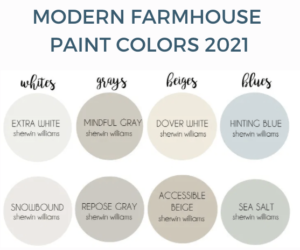
The color you paint your walls will determine the mood, style, and utility of the room. Color has a substantial impact on both feeling and concentration level- that’s why many kitchens have light paint, and many bedrooms or basements are darker. In addition, the color of a room will change the perceived size of the room.
Concentration
Concentration pertains to the concentration or intensity of the color. This can be an important consideration depending on the lighting choices in your room! It’s been proven that brightly lit areas engage the mind and improve concentration. In contrast, darker rooms typically encourage relaxation and are more commonly found in bedrooms or rest areas. Brightness isn’t the only “concentration factor” ― colors are also associated with feelings.
Mood
Paint color sets the mood of the room, influencing the feelings of your family and friends. Purple, blue, and green are often calming. However, while bright yellow and orange may light up the room, they also have been associated with anxiety or unrest. Red has been associated with hunger in some cases. So, make sure that the color paint you chose allows for either the alertness or restfulness of the room.
Size
Wall color and sheen determine how light reflects, which determines how large or small a room feels. Light neutral colors typically reflect the most light, regardless of sheen, and therefore make a room feel large and airy-- that’s why it’s popular in many current home designs. However, dark rooms or accent walls are also trending, making a room feel cozy, dramatic, or artistic.
Accent walls are a fun way to get both an airy space with a dramatic, darker touch. In addition, it can supply a focal point in the room to highlight your decor, family photos, and light fixtures!
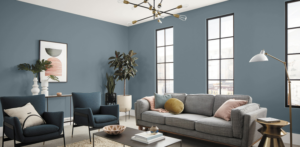
A moody room with great natural light. Photo: Sherwin-Williams
When choosing your paint color, natural lighting brings a variety of elements to consider. Your paint color can be influenced by ambient lighting and natural shadows, which can change the hue and the energy that your paint color brings to your room.
Natural lighting is likely affecting your space more than you think! For example, depending on where your windows face, you will get different warmth from the sun, affecting the perceived color of your paint. Eastern morning light introduces a blue tinge to the room, while the western evening light can bring a warm and yellow tone. When choosing a color, you should consider painting a few sample strokes onto the wall to evaluate what it looks like at different points in the day.
Lighting will change the perceived color in two main ways:
By doing an in-depth color analysis, you can capture the exact mood and tone you want to set in the room as you upgrade your space― automatically adding to resale value should you ever put it on the market.
Your paint choice can be a powerful way to tie in the flooring options that your home already has, or compliment new flooring. The two design elements can work synergistically to bring a unique energy to the room. For example, natural wooden floors or laminate flooring can bring a warmer tone into the room and would do well with neutral, warmer colors.
In contrast, if you have concrete, stone, or marble elements in your floor choices, cooler colors may be a stronger possibility to minimize differences and potential clashing. While colors do not need to match explicitly, many homeowners prefer complementary colors from the same color family― don’t overlook your floors when choosing your perfect paint color!
It is also important to note that you should experiment with colors that will enhance the beauty that your flooring choices bring into the room― you’ll want each design element to work together in one cohesive flow of the design.
Unique light fixtures and lamps can be like “jewelry” to your space and bring different hues in your room colors. Since color can look so different in natural and man-made light, make sure to consider your paint choices at different times of the day. Then you won’t be surprised once the entire room looks greener or bluer at night than you intended it to be.
While artificial light itself will impact the color of your paint, the color and style of the light fixtures will also affect how your wall paint will look. For example, you can pair a more neutral paint with pops of colorful light fixtures to pull a deeper color from the wall. Or you can balance a bold paint color with neutral light fixtures if you’re looking for a more dramatic look.
Whether you’re looking to organize your space or completely re-design and refresh your home, the experts at Macy Lane Designs are here to help. Our team of experts offers various premier home services, including paint consultations, interior design services, lighting packages and organizing for one room (or your entire living space), and so much more! So, connect with us today to learn about how you can make your home your haven.